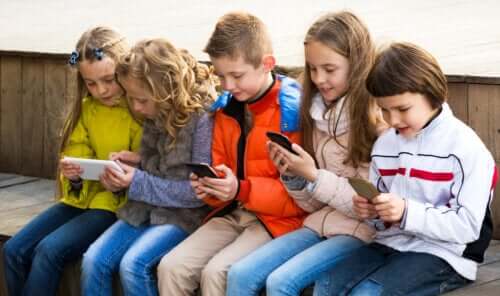The Impact of Social Media on Children

For many children, using social media has become an essential activity in their lives. Since a very early age, kids ask their parents or relatives for a phone. To avoid possible tantrums, many parents decide to give their children the phone they want. However, they don’t realize the risks kids may face in case of inappropriate use. So, what’s the impact of social media on children?
The constant evolution of new technologies has shaped the way children study, relate to their peers and spend their free time. As a result, the Internet and social media platforms, such as YouTube, Instagram, Twitter or Facebook have become essential for them to form relationships.
What do children like about social media?
According to a recent study, children from 5 to 8 years old don’t use social media platforms much. Instead, they prefer game apps. On the other hand, children over 9 years old prefer social media over other apps.

Nowadays, social media platforms and the Internet give children the opportunity to become real content creators. They get to express themselves, show their own experiences, and even record themselves in real time. Having a blog, a profile on a social media platform or being a YouTuber give children the opportunity to be heard. As a result, they become visible, social actors.
According to McQuail (2000), there are four types of rewards social media platforms offer their users:
- Fun, because it lets us escape from our pressures and problems. Therefore, it becomes an emotional escape.
- Personal relationships, through company and social utility. Social media allows us to communicate without moving from our homes.
- Personal identity as professional reference. It allows us to explore our reality and reinforce our values.
- Access to information about the world.
“In the past, you were what you had. Now, you are what you share.”
– Godfried Bogaard –
Impact of social media on children
Due to the anonymity and the possibility of creating false identities, Internet and social media may easily promote inappropriate behaviors. Examples of these behaviors could be exposure, aggression, scams, etc. Next, we’ll describe some of the dangers children may be exposed to:
- Grooming. This refers to a set of strategies adults develop to gain children’s trust through the Internet. Then, they try to control kids, in order to sexually abuse them.

- Cyberbullying or virtual violence. Nowadays, bullies use the virtual world as another means to exert violence over their peers. They usually do it through anonymity.
- Sexting. When sexting, people send nude or seminude pictures to each other. In this case, the biggest risk is that those private pictures could go viral.
- Cyberaddiction or addiction to the Internet. These are behavior patterns characterized by losing control of Internet use. This kind of behavior leads to isolation and to stop taking care of relationships, school, hobbies, health and personal hygiene.
“Social life has become an electronic or cyberlife.”
– Zygmunt Bauman –
Some tips to monitor your children
- Be a role model regarding the use of social media. Remember that adults are children’s closest examples.
- Reduce the time children are allowed to spend online.
- Promote family time, without the need of electronic devices.
- Check their web browser history.
- Talk to them about the risks and dangers they may face if they make inappropriate use of social media.
- Leave electronic devices outside their bedrooms during the night.
- Turn off the Wi-Fi during the night.
For many children, using social media has become an essential activity in their lives. Since a very early age, kids ask their parents or relatives for a phone. To avoid possible tantrums, many parents decide to give their children the phone they want. However, they don’t realize the risks kids may face in case of inappropriate use. So, what’s the impact of social media on children?
The constant evolution of new technologies has shaped the way children study, relate to their peers and spend their free time. As a result, the Internet and social media platforms, such as YouTube, Instagram, Twitter or Facebook have become essential for them to form relationships.
What do children like about social media?
According to a recent study, children from 5 to 8 years old don’t use social media platforms much. Instead, they prefer game apps. On the other hand, children over 9 years old prefer social media over other apps.

Nowadays, social media platforms and the Internet give children the opportunity to become real content creators. They get to express themselves, show their own experiences, and even record themselves in real time. Having a blog, a profile on a social media platform or being a YouTuber give children the opportunity to be heard. As a result, they become visible, social actors.
According to McQuail (2000), there are four types of rewards social media platforms offer their users:
- Fun, because it lets us escape from our pressures and problems. Therefore, it becomes an emotional escape.
- Personal relationships, through company and social utility. Social media allows us to communicate without moving from our homes.
- Personal identity as professional reference. It allows us to explore our reality and reinforce our values.
- Access to information about the world.
“In the past, you were what you had. Now, you are what you share.”
– Godfried Bogaard –
Impact of social media on children
Due to the anonymity and the possibility of creating false identities, Internet and social media may easily promote inappropriate behaviors. Examples of these behaviors could be exposure, aggression, scams, etc. Next, we’ll describe some of the dangers children may be exposed to:
- Grooming. This refers to a set of strategies adults develop to gain children’s trust through the Internet. Then, they try to control kids, in order to sexually abuse them.

- Cyberbullying or virtual violence. Nowadays, bullies use the virtual world as another means to exert violence over their peers. They usually do it through anonymity.
- Sexting. When sexting, people send nude or seminude pictures to each other. In this case, the biggest risk is that those private pictures could go viral.
- Cyberaddiction or addiction to the Internet. These are behavior patterns characterized by losing control of Internet use. This kind of behavior leads to isolation and to stop taking care of relationships, school, hobbies, health and personal hygiene.
“Social life has become an electronic or cyberlife.”
– Zygmunt Bauman –
Some tips to monitor your children
- Be a role model regarding the use of social media. Remember that adults are children’s closest examples.
- Reduce the time children are allowed to spend online.
- Promote family time, without the need of electronic devices.
- Check their web browser history.
- Talk to them about the risks and dangers they may face if they make inappropriate use of social media.
- Leave electronic devices outside their bedrooms during the night.
- Turn off the Wi-Fi during the night.
All cited sources were thoroughly reviewed by our team to ensure their quality, reliability, currency, and validity. The bibliography of this article was considered reliable and of academic or scientific accuracy.
- Arab, L. E., & Díaz, G. A. (2015). Impacto de las redes sociales e internet en la adolescencia: aspectos positivos y negativos. Revista Médica Clínica Las Condes, 26(1), 7-13.
- McQuail, D. (2000). Introducción a la teoría de la comunicación de masas. Barcelona: Paidós.
This text is provided for informational purposes only and does not replace consultation with a professional. If in doubt, consult your specialist.








